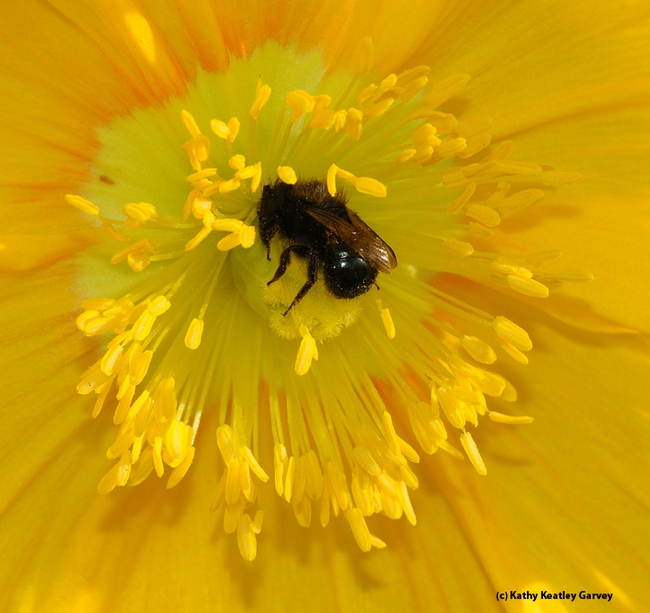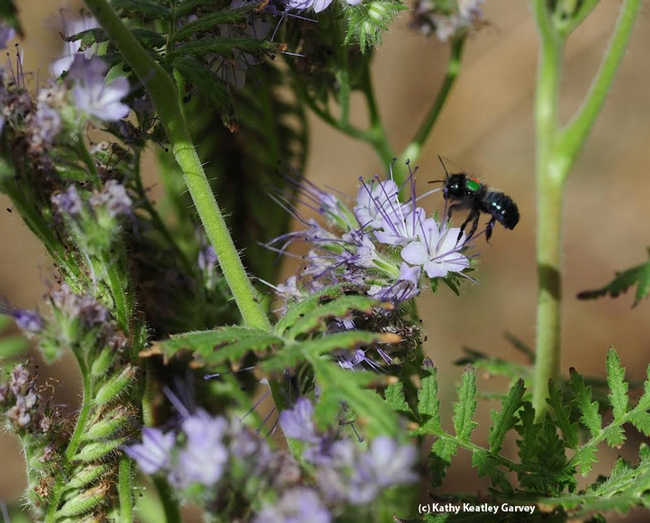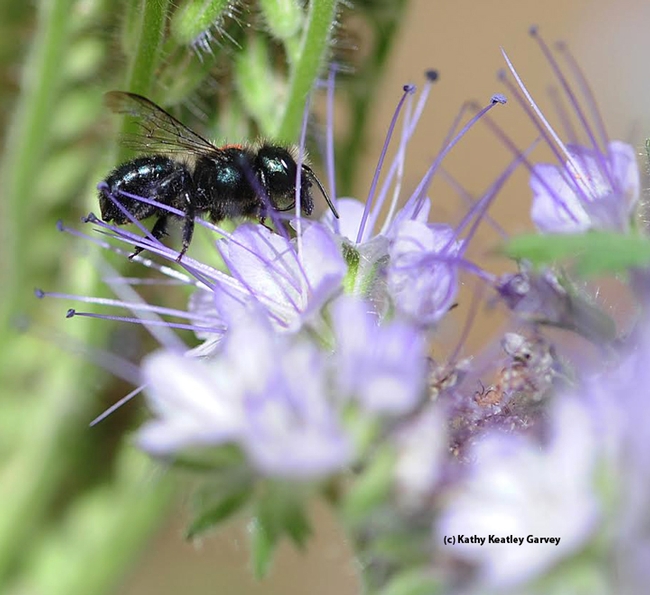- Author: Kathy Keatley Garvey
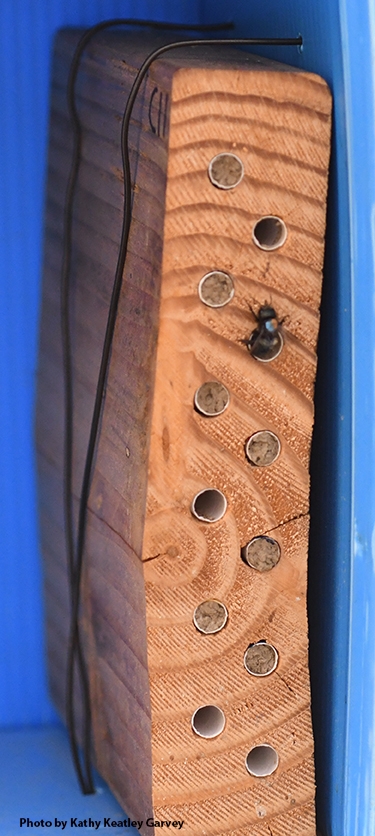
Lead author and doctoral student Clara Stuligross teamed with her major professor, pollination ecologist Neal Williams of the UC Davis Department of Entomology and Nematology, to publish Pesticide and Resource Stressors Additively Impair Wild Bee Reproduction, in the journal Proceedings of the Royal Society B.
They exposed the bees to the neonicotinoid insecticide imidacloprid, widely used in agriculture, and found that the combined threats—imidacloprid exposure and the loss of flowering plants—reduced the bee's reproduction by 57 percent, resulting in fewer female offspring.
Of the two stressors—food scarcity and pesticide exposure—pesticide exposure showed the great impact on nesting activity and the number of offspring produced, they said.
Other scientists have conducted similar research on honey bees, but this is the first comparable research on wild bees in field or semi-field conditions.
The blue orchard bee, nicknamed BOB, is a dark metallic mason bee, smaller than a honey bee. It is prized for pollinating almond, apple, plum, pear, and peach trees. California almond growers often set up bee boxes or "bee condos" for blue orchard bees to aid in honey bee pollination. In the wild, the bees nest in reeds or natural holes.
“Bees and other beneficial insects experience multiple stressors within agricultural landscapes that act together to impact their health and diminish their ability to deliver the ecosystem services on which human food supplies depend,” Stuligross and Williams wrote in their abstract. “Disentangling the effects of coupled stressors is a primary challenge for understanding how to promote their populations and ensure robust pollination and other ecosystem services.”
To study the survival, nesting and reproduction of the blue orchard bee, they set up nesting females in large flight cages, some with high densities of wildflowers and others with low densities that were treated “with or without the common insecticide, imidacloprid.” Bees are commonly exposed to insecticides when they forage on treated flowers.
“Pesticides and resource limitation acted additively to dramatically reduce reproduction in free-flying bees,” they wrote in their abstract. “Our results emphasize the importance of considering multiple drivers to inform population persistence, management, and risk assessment for the long-term sustainability of food production and natural ecosystems.”
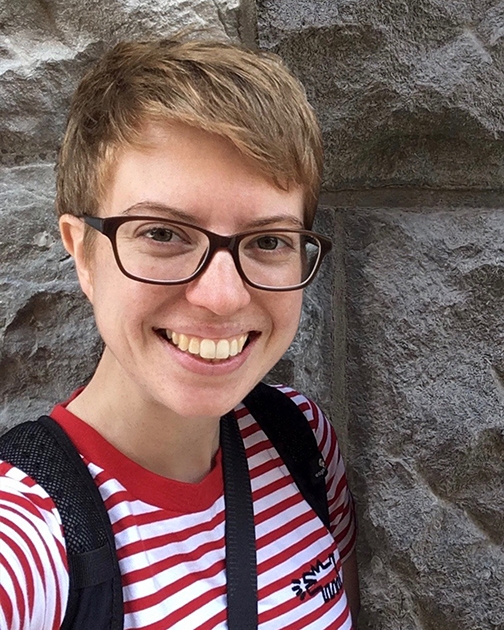
Key factors in affecting bee reproduction are the probability that females will nest and the total number of offspring they have. The UC Davis research found that pesticide-exposed and resource-deprived female bees delayed the onset of nesting by 3.6 days and spent five fewer days nesting than unexposed bees.

They found that only 62 percent of pesticide-exposed bees produced at least one daughter compared to 92 percent of bees not exposed to pesticides.
The research, accomplished in the spring of 2018 on the grounds of the Harry H. Laidlaw Jr. Facility west of the campus, drew support from a UC Davis Jastro Research Award, a UC Davis Ecology Graduate Research Fellowship, a National Science Foundation Graduate Research Fellowship, and the UC Davis bee biology facility
The blue orchard bee bee is one of the few native pollinators that is managed in agriculture. North America has 140 species of Osmia, according to a Pollinator Partnership (PP) article in a U. S. Forest Service publication, authored by entomologist and PP member Beatriz Moisset and PP director Vicki Wojcik. “Mason bees use clay to make partitions and to seal the entrance,” they wrote. “This unique mud-building behavior leads to their common designation as mason bees. Honey bees are very important to commercial agriculture, but native bees like the blue orchard bees are better and more efficient pollinators of native crops.”
Imidacloprid, a systemic insecticide that acts as an insect neurotoxin, is used to control sucking insects, termites, some soil insects and fleas on pets, according to National Pesticide Information Center. It mimics nicotine, toxic to insects, which is naturally found in many plants, including tobacco. More than 400 products for sale in the United States contain imidacloprid.
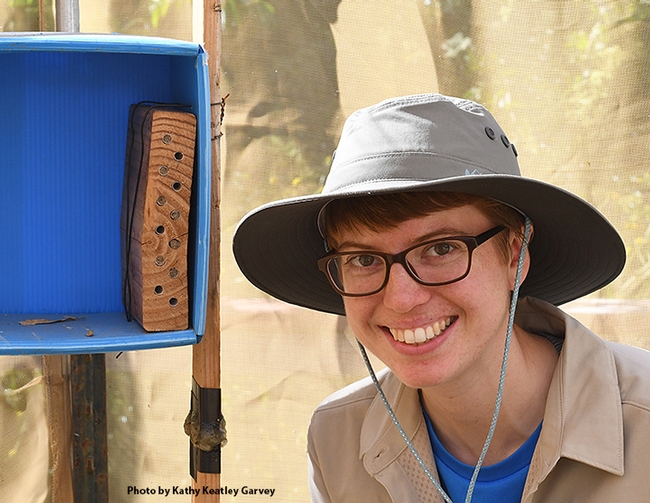
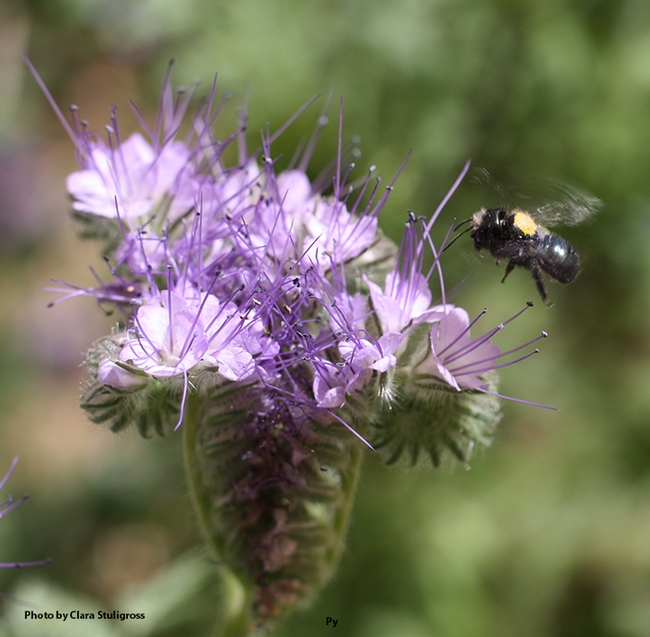
- Author: Kathy Keatley Garvey
Talk about a good insurance policy.
Researchers at Michigan State University (MSU) just published an article in the Journal of Applied Ecology that indicates that blueberry growers who invest in nearby wildflower habitat to attract and support wild bees can increase their crop yields. They're saying that the cost of planting a habitat for wild bees can pay for itself in four years or less.
"Other studies have demonstrated that creating flowering habitat will attract wild bees, and a few have shown that this can increase yields," MSU entomologist and co-author Rufus Isaacs said in a press release. "This is the first paper that demonstrates an economic advantage. This gives us a strong argument to present to farmers that this method works, and it puts money back in their pockets."
"This is HUGE news," said pollination ecologist Neal Williams, associate professor of entomology at UC Davis, who was not involved in the study. "This is the first study to quantify pollination benefit as a result of habitat planting adjacent crops. It also works through the economics of the implementation of the the habitat and accrued economic and yield benefit over time. Fantastic stuff."
This is right up Willilams' alley, er, hedge row. He and his colleagues are exploring the role of wild native bees, honey bees and other managed species as crop pollinators and the effects of landscape composition and local habitat quality on their persistence. His research on pollination spans the disciplines of conservation biology, behavioral ecology and evolution. One of his primary research foci is on sustainable pollination strategies for agriculture. This work is critical given ongoing pressures facing managed honey bees and reported declines in important native pollinators such as bumble bees.
Williams' research has taken him from eastern Pennsylvania and New Jersey to California's Central Valley. "A continuing goal is to provide practical information that can be used to improve the long-term stability of pollination for agriculture in California, as well as promote pollinator conservation and management," Williams says. In addition to work in agriculture, he is also studying how habitat restoration affects pollinator communities and pollination.
Earlier California studies, involving Clare Kremen of UC Berkeley, Neal Williams and other colleagues, showed that wild bees make honey bees better pollinators; that is, the presence of wild bees makes the honey bees work harder.
Regarding the MSU study, the research team planted surrounding bueberry fields with a mix of 15 native perennial wildflowers, hoping to increase the wild bee population and thus improve pollination in the blueberry fields.
And yes, that's exactly what happened.
"In the first two years as the plantings established, we found little to no increase in the number of wild bees," Isaacs related in the press release "After that, though, the number of wild bees was twice as high as those found in our control fields that had no habitat improvements."
To quote from the press release: "Once the wild bees were more abundant, more flowers turned into blueberries, and the blueberries had more seeds and were larger. Based on the results, a two-acre field planted with wildflowers adjacent to a 10-acre field of blueberries boosted yields by 10-20 percent. This translated into more revenue from the field, which can recoup the money from planting wildflowers."
Isaacs was quick to point out that the researchers are not suggesting that growers cease using honey bees for pollination services. But with 420 species of wild bees in Michigan alone, he says, it makes sense to attract the "free" wild bees. Indeed, it does.
This study could have major implications for not only research in California, but nationwide.
